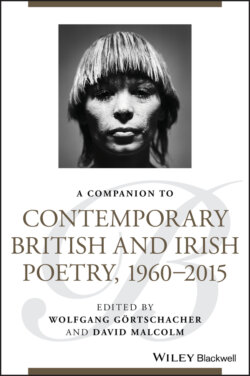Читать книгу A Companion to Contemporary British and Irish Poetry, 1960 - 2015 - Группа авторов - Страница 20
John Montague, “The Rough Field” (1972) (Montague 1989, 12–13)
ОглавлениеThe third section of Chapter 1 of The Rough Field (“Between small whin‐tough fields”) begins with a marginal note (as many sections of the collection do). The prose paratext contextualizes the account of the speaker's grandfather that follows, and gives the poem a rooting in a documented history and reality. It consists of three verse paragraphs of approximately the same length, organized in a perspicuous manner. First, there is a situation, captured in a daguerreotype of the speaker's grandparents; second, there is the origin of that situation, a post‐Famine Ireland in which some Catholics achieve some measure of advancement. Third, the poem shifts to 60 years later, the dispersal of the patriarchal Montague's family and the changes that time has wrought on his farm.
The text is on the border of speech and verse. Lines are of a wide variety of lengths. A line is usually made of a coherent phrase (there are only 6 examples of enjambment in the poem's 43 lines). There is a relaxed rhythmic patterning, for most lines have three or four main stresses, and even the two broken lines at the paragraph breaks, when taken together, follow this pattern. Three lines are more densely stressed with five main stresses: line 16, emphasizing post‐Famine mobility; line 20, embodying that mobility; and line 36, pointing to the endurance of agriculture despite the decline of the Montague farmhouse. The same kind of unobtrusive patterning can be seen in phonological aspects of the text: paragraphs 1 and 3 are governed by /s/ sounds, and even in the much less phonologically organized second paragraph, lines 16–18 are woven with /r/ sounds, and lines 19 and 20 with /p/ sounds, while /s/ runs through the paragraph up to line 24. Lines 25–29 (semantically and historically crucial) evade the prevailing /s/ patterning of the rest of the text.
The poem does drift into rhyme of sorts on occasion: lines 26 and 29—“Puritan / gentleman”; lines 30 and 31—“broken / Brooklyn”; and lines 42 and 43—“stove / stone.” Such rhymes have an ironizing effect: “rustic gentleman” is nearly an oxymoron, even without the odd rhyme; pride is brought low and broken in Brooklyn; the assonance of “stove / stone” makes clear the point about the reduction of the heroic past. Similarly, the poem slips from a prosaic literalness in the double meanings of “spirit” (line 11)—vitality and alcohol; “conceit” (line 16)—arrogance and a cunning image; and “Tagues” (line 25)—both a family name and an abusive term for Catholics. But these slippages are rare. The poem says precisely what it means on the surface. It offers an account of a patriarch, his personal rise in the context of social change, a decline brought by time, and the endurance of agriculture (“Dagda's cauldron” [line 41]) that outlasts human transience. The poem is a personal account and a broader social and historical account, seen within a context of a continuance of older ways of cultivation and planting.
